Mammals of the Adirondacks:
Red Squirrel (Tamiasciurus hudsonicus)
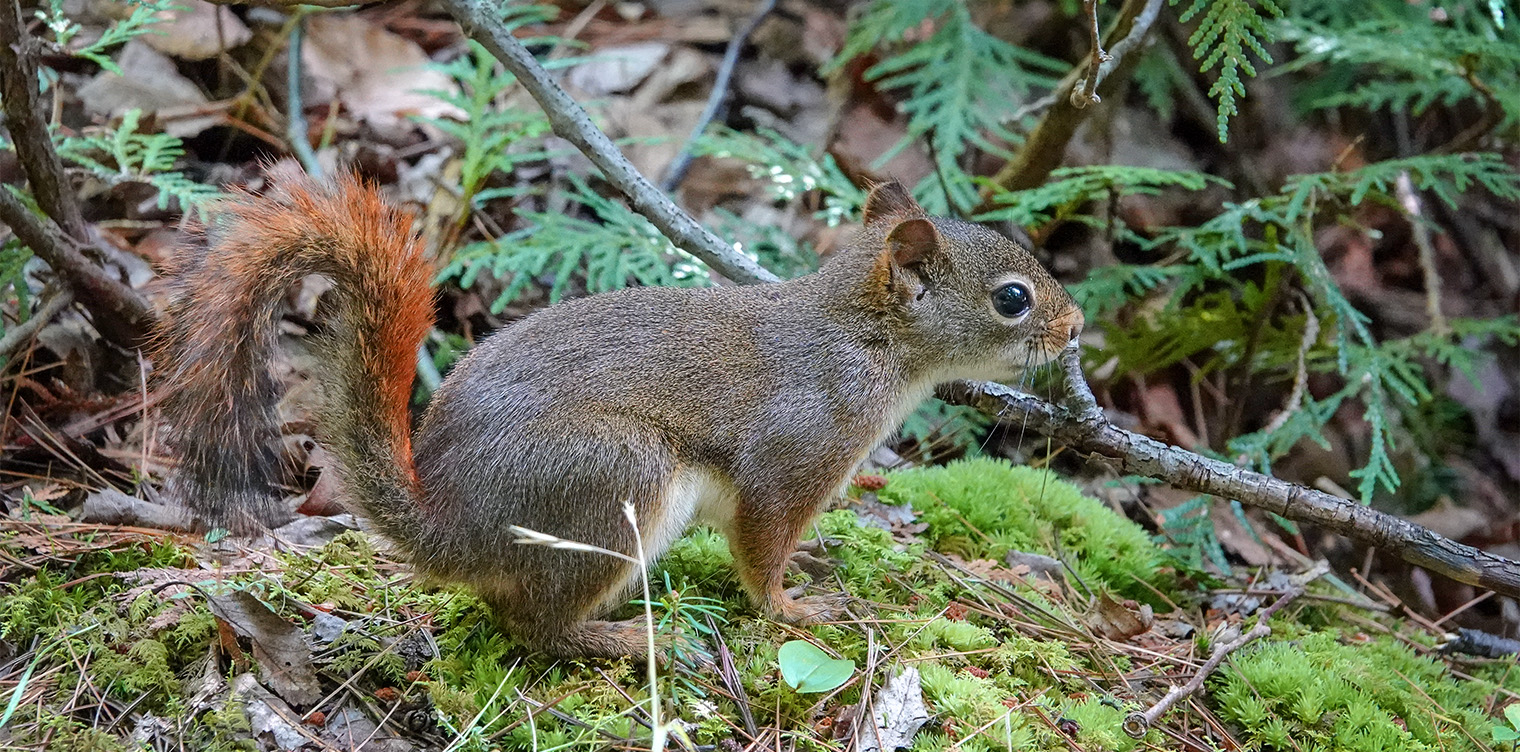
The Red Squirrel (Tamiasciurus hudsonicus) is a small, noisy, reddish-brown rodent found in coniferous and mixed wood forests in the Adirondack Mountains of upstate New York. Red Squirrels (like American Beaver and North American Porcupine) are assigned to the rodent (Rodentia) order, the single largest group of mammals.
The Red Squirrel is one of six members of the squirrel family (Sciuridae) who make their home in the Adirondacks. The other members are:
The genus name (Tamiasciurus) is derived from a combination of three Greek words: tamias (animal who caches food), skia (shadow) and oura (tail). The latter two words are a reference to the squirrel using its own tail as a source of shade.
- The species name (hudsonicus) is said to refer to the Hudson Bay region, where the type specimen was obtained.
- There are 25 recognized subspecies. Sources conflict on the identity of our subspecies. Several general treatments of the Red Squirrel show the Adirondack version as T.h. loquax. However, Robert Hatt's 1929 survey of the Red Squirrel in the Adirondacks states that our Adirondack Red Squirrels fall into the subspecies gymnicus.
Other nonscientific names include Pine Squirrel, Chickaree, Piney Squirrel, Fairy Diddle, Piney, Rusty Squirrel, Spruce Squirrel, Boomer, and Chatter-box. The last two names point to the squirrel's well-earned reputation for noisiness. The references to pine and spruce stem from the Red Squirrel's reliance on seeds from conifers.
Red Squirrel: Description
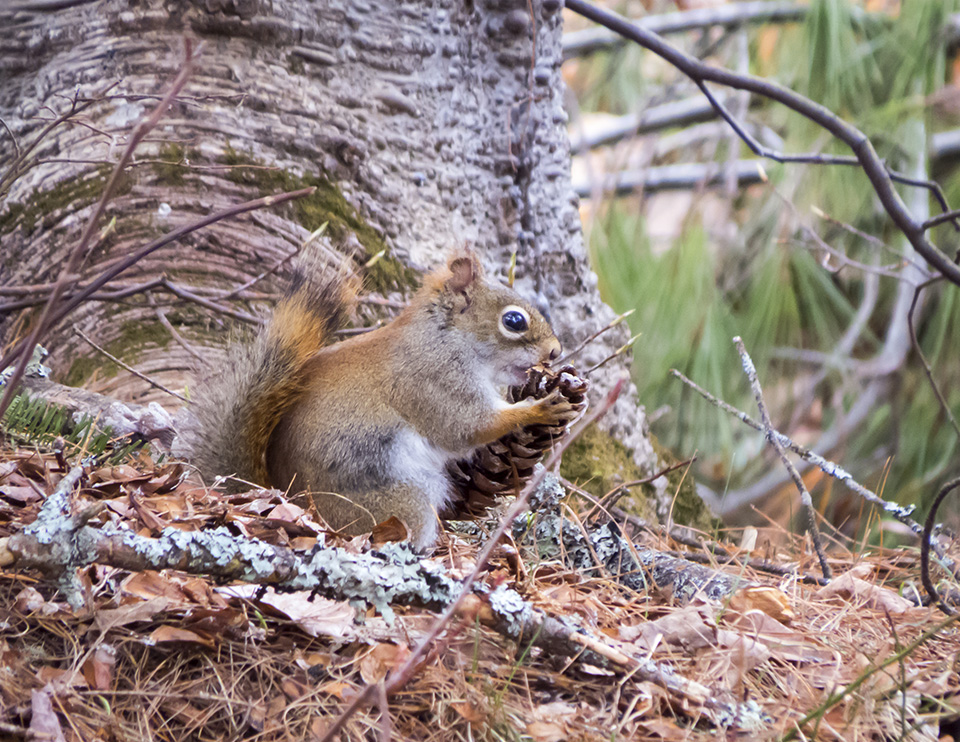
Red Squirrels are small reddish brown rodents with large dark eyes, made more prominent by thick bright white eye-rings. The Red Squirrel is about 11-13 inches long (including the tail), weighing in at about 5-8 ounces. The upper parts of the animal and the outside of the legs are chestnut red, grayish red, brownish red, or olive-red. The belly, chest, and chin are white.
Red Squirrels have long, bushy tails accounting for nearly a third of its total length and often carried over or against the back. The tail is rusty; the hair on the tail is tipped with white or tawny-red. The tail helps the squirrel to balance while climbing and leaping. It also is said to provide a wrapper when the squirrel is resting in cold weather. The squirrel's back legs are larger than its fore legs.
Red Squirrels undergo two molts per year, resulting in seasonal differences in appearance. The winter molt, which begins in the hindquarters and progresses toward the head, reportedly commences in November in New York State and is complete by the end of the year. The summer molt, which beings in the nose region and moves toward the tail, begins in May is and said to be complete by early June. The tail molt reportedly occurs only once per year.
The Red Squirrel's winter coat is usually described as brighter than the summer coat, and the squirrels develops short ear tufts. The coat is a softer red in summer, with a black line separating the upper body coat from the white belly. This band of black, sometimes described as prominent, is apparently somewhat variable; it is not immediately obvious on some of the summer photos of our Adirondack Red Squirrels provided in iNaturalist.
The main clues to identifying the Red Squirrel and distinguishing it from other rodents found in the Adirondacks are size, color, markings, and activity pattern.
- Red Squirrels are larger than Eastern Chipmunks, which average 9.6 inches in length and weigh about three ounces. They also have prominent longitudinal stripes on their bodies and spend much of their time on the ground.
- Gray Squirrels, at 18 to 20 inches in length and 1½ pounds, are much larger than Red Squirrels and have gray (or in some cases, black) coats.
- Northern Flying Squirrels and Southern Flying Squirrels have large black eyes (lacking the eye ring of Red Squirrels) and brownish coats with a furry membrane between the front and rear legs used to glide through the air. Unlike Red Squirrels, which are diurnal Diurnal: Active during the day, followed by a period of inactivity or sleeping during the night. Nocturnal animals are active primarily at night, while animals that are active in the twilight hours (dawn and dusk) are crepuscular., flying squirrels are nocturnal.
Red Squirrel: Diet
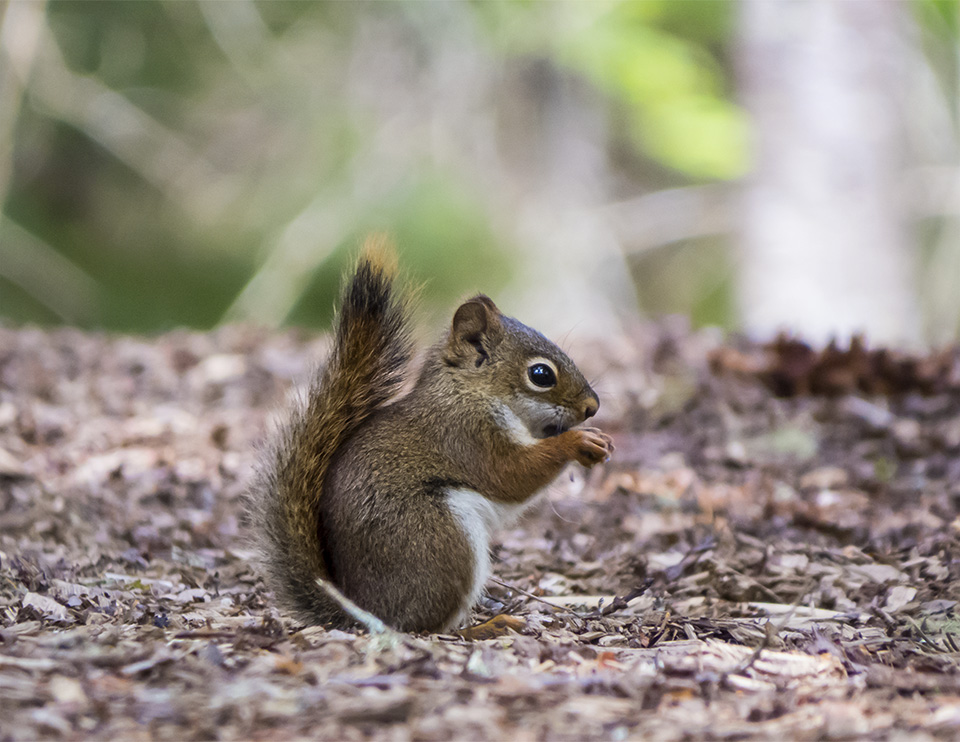
The Red Squirrel is an omnivore Omnivore: Animals that eats both plant- and animal-derived food. Carnivores (meaning "meat-eaters" in Latin) are animals that feed on other animals; obligate carnivores (such as members of the cat family) rely entirely on animal flesh, while facultative carnivores supplement their diets with non-animal foods. Herbivores feed exclusively on plants, although some may supplement their diets with small amounts of insects or other animals. , meaning that it consumes both plant and nonplant material. Plant material is the squirrel's mainstay, and a large variety of plant food is consumed, depending on the season and local availability.
In the Adirondacks, the main items on the Red Squirrel's menu are seeds from conifer cones.
- Red Squirrels harvest the cones when they are green, climbing along the branches to snip off the cones and then descending to retrieve them. The cones are gathered when green to prevent the seeds from ripening and dispersing.
- Using its dexterous front paws, the squirrel extracts the seeds from the cones, leaving behind piles of cone fragments called middensMidden: A pile serving as a food cache or a pile of debris from conifer cones..
Red Squirrels consume seeds from a variety of conifers in our area, including pines (Eastern White Pine, Red Pine, Jack Pine, and Pitch Pine), spruce (Red Spruce, White Spruce), Balsam Fir, and Eastern Hemlock. Red Squirrels in our area also feed on the buds of spruce, willows, Tamaracks, and Bigtooth Aspen, as well as the catkins of Paper Birch and Yellow Birch.
The Sugar Maple is another important food source for Red Squirrels in the Adirondack Park.
- The bark reportedly is eaten during all seasons.
- In the early spring, Red Squirrels consume the sweet sap. They tap the maple by making incisions in the bark; they also take advantage of the sap running from branches torn off by the wind and from holes dripped by Yellow-bellied Sapsuckers.
- Seeds from both Sugar Maples and Red Maples are also on the Red Squirrel menu.
Nuts and berries are also consumed, including beechnuts from American Beech and acorns from Northern Red Oak and White Oak. Red Squirrels also eat the nuts from Beaked Hazelnut and American Hazelnut and the berries of Northern Wild Raisin, Wintergreen, and Partridgeberry.
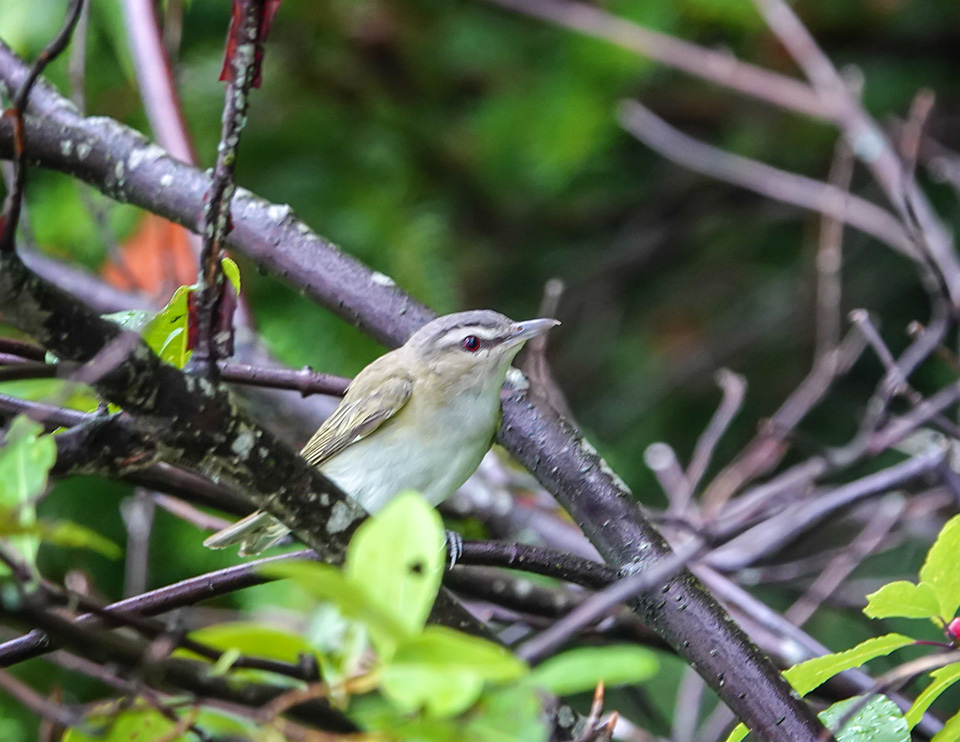
Red Squirrels supplement their diets in summer and fall with fungi. Individual mushrooms may be stored in the lower limbs of trees, apparently to dry for later consumption. Red Squirrels eat a wide variety of fungi, including some, such as Amanita muscaria (Fly Amanita) which are toxic to humans.
Although Red Squirrels are primarily herbivores, they also consume insects, worms, and vertebrates, including small mammals (such as newborn Snowshoe Hares) and birds. They are considered to be more carnivorous than other tree squirrels, including Gray Squirrels.
The animal food of choice for Red Squirrels appears to be birds. Red Squirrels are probable or confirmed nest predators of a long list of bird species. Documented predation by Red Squirrels has been recorded for many of the birds that live full time or seasonally in the Adirondacks, including American Goldfinch, American Redstart, American Robin, Baltimore Oriole, Bicknell's Thrush, Black-throated Blue Warbler, Common Redpoll, Golden-crowned Kinglet, Gray Catbird, Northern Flicker, Ovenbird, Red-breasted Nuthatch, Red-eyed Vireo, Rose-breasted Grosbeak, Ruby-crowned Kinglet, Rusty Blackbird, Spruce Grouse, Swainson's Thrush, Winter Wren, Yellow-rumped Warbler, and Yellow Warbler. In most cases, Red Squirrels do not prey on the adult birds, but rather raid the nests and consume the eggs or nestlings.
Red Squirrel: Reproduction and Family Life
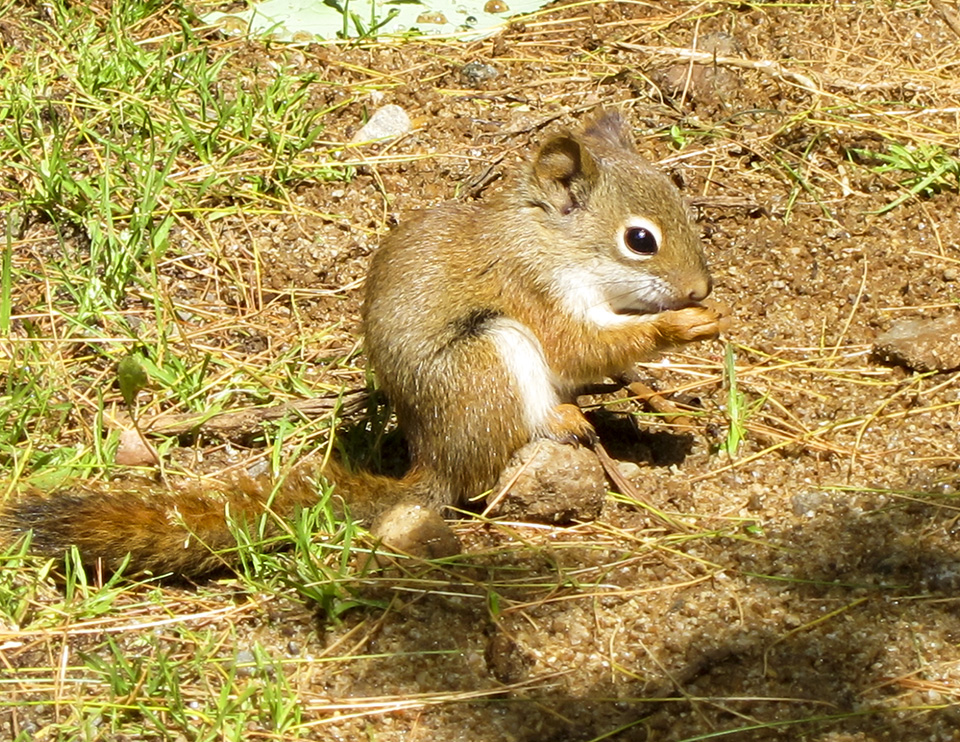
Red Squirrel breeding season varies, depending on location. This species mates either once or twice a year, with gestation averaging 31 to 35 days. Red Squirrel populations in the western US reportedly breed only once a year, generally in the spring. In the East, some Red Squirrels have two litters per year, in the spring and in late summer.
- In the Adirondack Park, the spring breeding season reportedly occurs in February and March, with litters born in April and May.
- The summer breeding season in the Adirondacks is said to be in June and July, with litters born in August and September.
Red Squirrel courtship is brief, as females have an estrous period of only one day, after which the male returns to his territory and plays no role in rearing of the young. The female gives birth to a litter of three to five young.
The young are born in a nest consisting of twigs, shredded bark, moss, and leaves.
- In the Adirondacks, according to Hatt's 1929 study, Red Squirrels build nests in tree and stump cavities, stone walls, underground burrows and branches of trees.
- The preferred nest location is said to be in a tree cavity, either a natural cavity or one excavated by woodpeckers. In the northern Adirondacks, where such cavities may not be available in forests dominated by conifers, outside nests (constructed against the trunk of the tree or straddling the base of several branches) may be more common.
Red Squirrel young are born blind and without fur. They open their eyes at 27 to 35 days and develop fur by about eight weeks. Weaning occurs at seven to eight weeks. Young squirrels begin foraging outside the nest at about ten weeks. Juvenile Red Squirrels reportedly disperse beginning at about 12 to 14 weeks.
Red Squirrel: Behavior
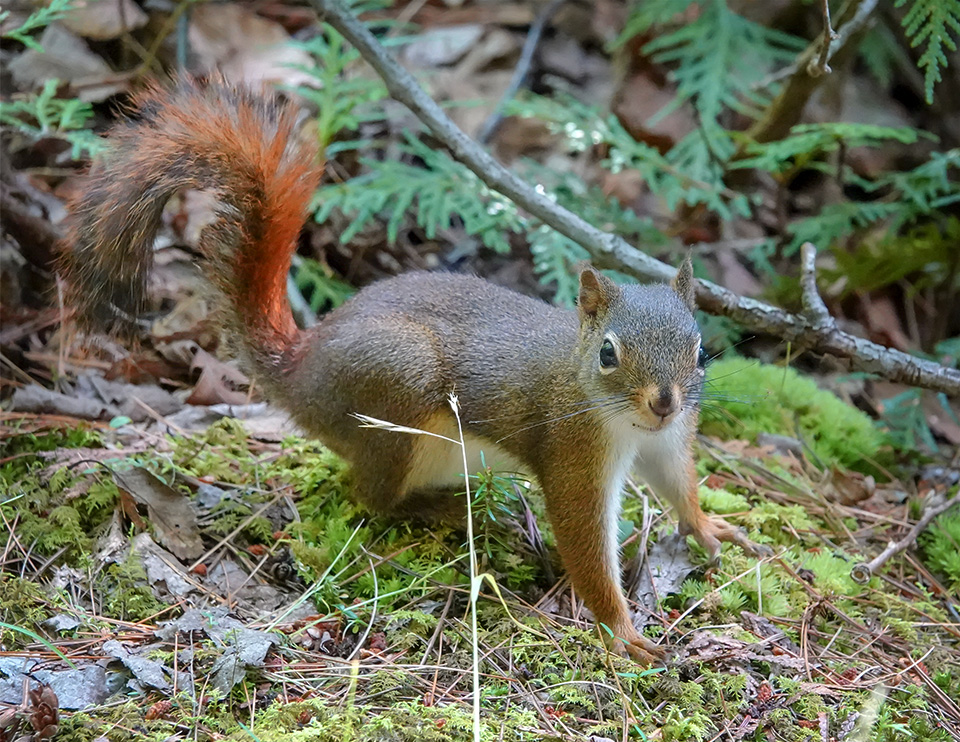
Activity Patterns:
Like other pine squirrels, Red Squirrels are diurnal Diurnal: Active during the day, followed by a period of inactivity or sleeping during the night. Nocturnal animals are active primarily at night, while animals that are active in the twilight hours (dawn and dusk) are crepuscular., meaning that they are active during daylight hours. In the spring and summer, activity levels reportedly peak in the morning and again later in the afternoon. Hatt's 1929 study of Adirondack Red Squirrels suggests that the squirrels took a midday rest in the warmer months between 1:30 and 3:00 PM, confirming Klugh's 1927 report on the activity patterns of Ontario squirrels.During winter, Red Squirrel activity is said to peak in midday to take advantage of the warmer temperatures. They do not hibernate in winter (like Woodchucks) or spend winter in their dens in a state of intermittent torpor (like Eastern Chipmunks). Red Squirrels are active in all four seasons, but may spend a day or two resting in their den during bad winter weather.
Although Red Squirrels spend a fair amount of time on the ground, they are more at home in the trees than Eastern Chipmunks. Red Squirrels seem more confident in the trees than on the ground, running up tree trunks when threatened and scampering from tree to tree along horizontal branches.
Red Squirrels are also said to be accomplished swimmers, able to swim fairly long distances. Early studies of Red Squirrels in the Adirondacks report sightings of squirrels swimming across Brantingham Lake, Big Moose Lake, Long Lake, and Lake George.
Social System:
Red Squirrels are solitary and territorial. Home ranges of adult males in New York State reportedly range from ½ to about 11 acres and average about six acres. In the Adirondacks, Red Squirrel territories reportedly range from one to eight acres.Red Squirrels are said to be more territorial than most other North American tree squirrels. Individual Red Squirrels will fiercely defend their territory against other squirrels, except for a brief period during breeding season when the female squirrel will permit encroachment by males while in her one-day estrous.
Red Squirrels defend their territories primarily through vocalization, although they may also resort to an actual attack with teeth and forepaws. They are also very aggressive and will fearlessly assault the much larger Gray Squirrel, which usually retreats in the face of its smaller, but more pugnacious, rival.
Vocalization:
This species is extremely vocal, fully living up to its reputation as chatter-boxes. They use five calls: the chirp (an alarm to advertise the presence of potential predators; a rattle call (used in territorial defense); a screech call (also used to defend territory), a growl (used in more aggressive defense against another squirrel); and a buzz call (used when males attempt to approach females).Red Squirrels usually react to a hiker intruding on their territory with an outburst of indignant calls, punctuated by vehement jerks of the body, angry tail-jerking, and irate foot-stomping. A particularly annoyed Red Squirrel might keep up its scolding for up to an hour.
Red Squirrel: Mortality and Predators
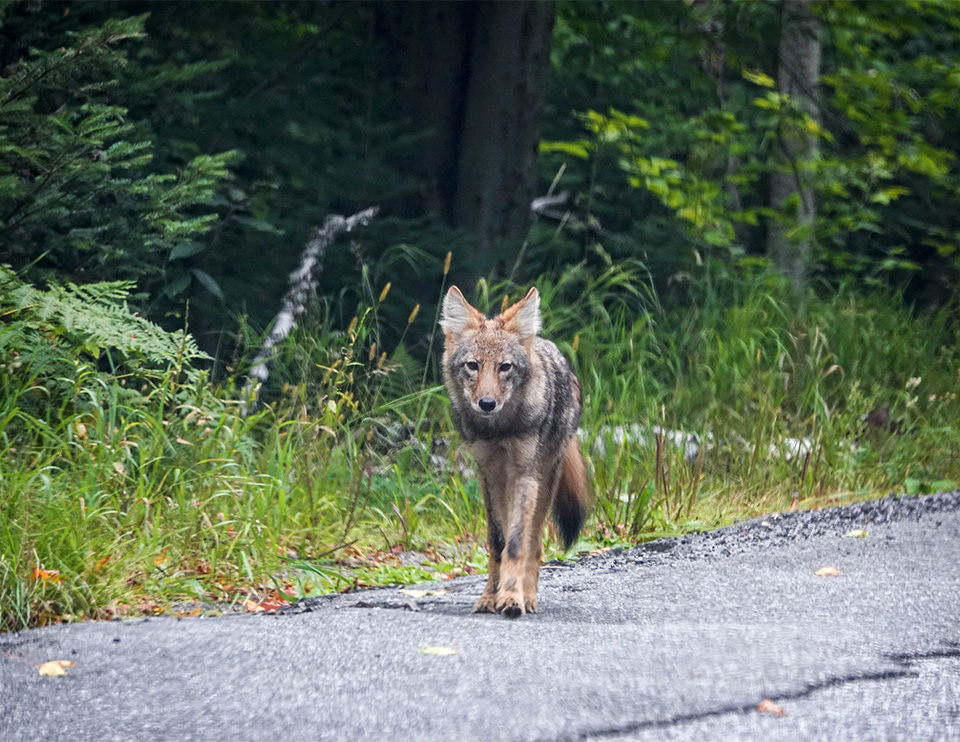
Red Squirrels are a significant prey item Fishers and American Martens.
- A 1955 study of fishers in the Adirondacks found Red Squirrel remains in 17% of the Fishers taken in the Adirondack region from 1949 through 1953.
- A 1979 study of the food habits of Fisher in the Adirondack region found that the principle species preyed upon were Red Squirrel, Snowshoe Hare, and Meadow Vole. Red Squirrel remains were found in in the digestive tracts of 20% of the Fishers trapped during late fall and early winter.
Other Adirondack mammals that prey on Red Squirrels include Ermine, Long-tailed Weasel, Raccoon, Red Fox, and Eastern Coyotes. A study of coyote food habits in the Adirondack region from 1956 to 1961 found that 10% of the scats collected in summer and fall contained Red Squirrel remains, as did 8% of the scats collected in the winter.
Red Squirrels are also a significant prey item for the Northern Goshawk. Other birds that prey on Red Squirrels include Red-shouldered Hawk, Sharp-shinned Hawk, Rough-legged Hawk, Red-tailed Hawk, Cooper's Hawk, Northern Harrier, Bald Eagle, and American Kestrel. Several species of owls are also listed among the Red Squirrel's known predators, including Great Horned Owls and Barred Owls.
Human sources of mortality for Red Squirrels include trapping, hunting, and motor vehicles. In New York State, Red Squirrels are an unprotected species, meaning that they can be taken at any time without limit. Hunting appears to be a significant contributer to Red Squirrel mortality in Canada, where they are said to be the third-most commonly harvested furbearer. Statistics on US Red Squirrel hunting were not found, although Gray Squirrels and Fox Squirrels appear to be a popular target for New York State hunters.
The impact of all sources of mortality on Red Squirrel longevity is significant. Although Red Squirrels may survive up to nine to ten years in the wild, only about 40% survive beyond 12 months.
Red Squirrel: Distribution
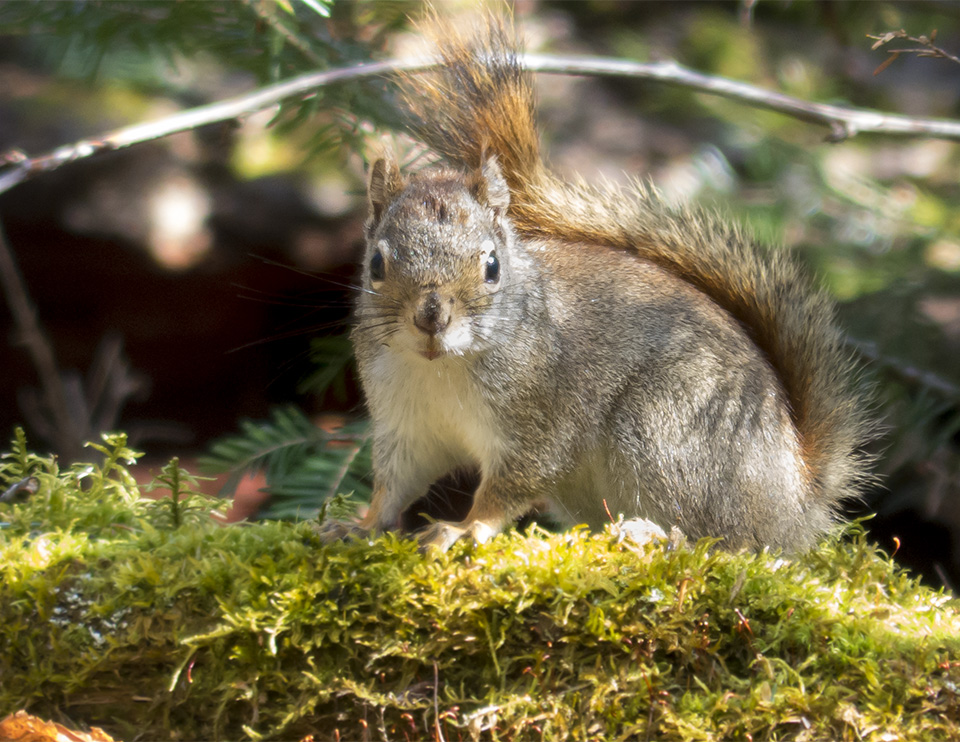
Red Squirrels are widespread and common throughout much of northern Canada and Alaska. In the continental US, their range includes Wisconsin, Michigan and Maine south through northern Indiana and Ohio and through the Allegheny Mountains.
Red Squirrels are found throughout New York State. Red Squirrel populations show seasonal and regional fluctuations, with population dynamics closely associated with the cone crops of coniferous trees. Years when trees produce many cones are generally followed by Red Squirrel population growth.
Although studies of relative abundance of Red Squirrels and Eastern Chipmunks in the Adirondack region suggest that Eastern Chipmunks are more abundant, the Red Squirrel has been described as the most often-seen of our Adirondack mammals. This may be related to the fact that Red Squirrels tend to be extremely noisy, drawing attention to themselves. They also make their presence known by raiding bird feeders in winter and early spring.
Red Squirrel Habitat
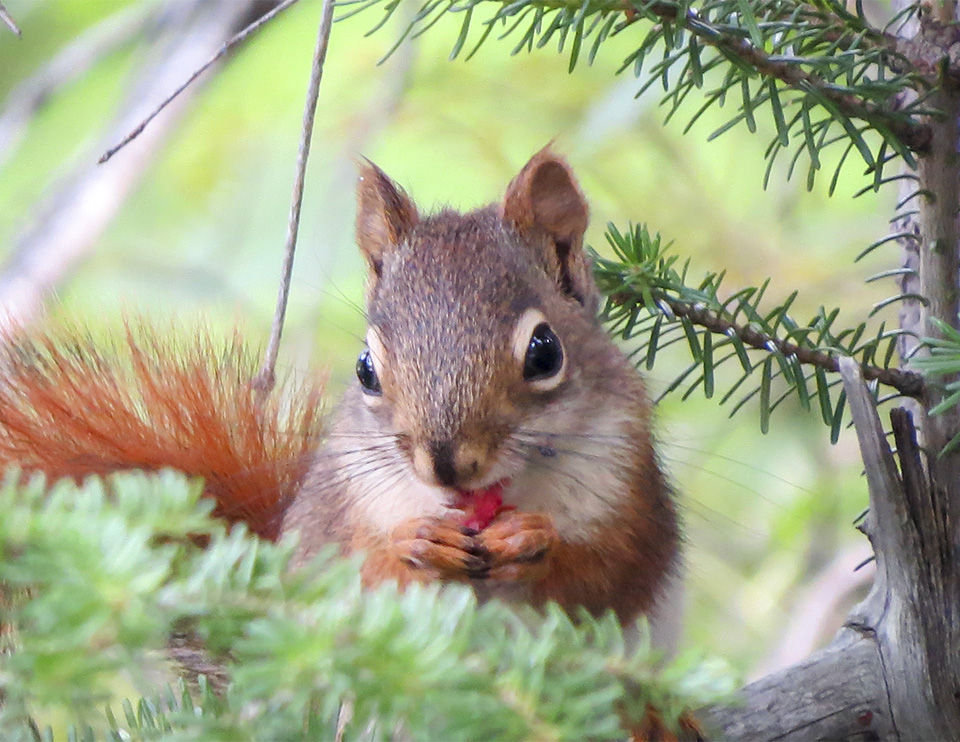
In the Adirondack Mountains, Red Squirrels inhabit both conifer and mixed wood forests at all elevations. Both Red Squirrels and Eastern Chipmunks can be found in mixed wood forests and village gardens. However, in contrast to the Eastern Chipmunk, which is most abundant in northern hardwood forests, the Red Squirrel favors habitat which include mature conifer trees to provide abundant conifer seeds and high canopy closure to provide cover. While Red Squirrels can be found in mature hardwood forests that have some spruce, Eastern Hemlock, or Balsam Fir, they are rare in pure hardwood stands.
Hatt's 1929 study of the Red Squirrel in the Adirondacks noted that this species was almost invariably associated with Red Spruce or Balsam Fir. His observations suggest that Red Squirrel abundance varied regionally, with Red Squirrels in the southern Adirondacks preferring sites with Red Spruce, while those near Lake Placid were common in Balsam Fir stands. Second-growth mixed wood forests were found to have resident Red Squirrels in direct ratio to the abundance of spruce.
Where to See Red Squirrels in the Adirondacks
Red Squirrels can be seen along virtually all of the trails covered here, particularly those portions of the trails which pass through conifer and mixed wood forests. Visual clues to their presence include tracks in mud or snow, nests in trees, cone debris in middensMidden: A pile serving as a food cache or a pile of debris from conifer cones., and mushrooms either with bite marks or placed in trees. The easiest way to spot a Red Squirrel is to listen for its loud chatter. Red Squirrels are also frequent visitors to winter bird feeders, so look for them foraging under the feeder for seeds dropped by birds.
Adirondack Mammal List
References
New York State Department of Environmental Conservation. Small Game Hunting. Retrieved 4 February 2019.
State University of New York. College of Environmental Science and Forestry. Red Squirrel. Retrieved 29 March 2017.
David Figura. DEC survey: What animals are most popular among New York's small game hunters? Retrieved 28 January 2019.
Janet Sullivan. Tamiasciurus hudsonicus in Fire Effects Information System (FEIS). Species Reviews. Forest Service, Rocky Mountain Research Station, Fire Sciences Laboratory (United States Department of Agriculture, 1995). Retrieved 20 January 2019.
Smithsonian National Museum of Natural History. North American Mammals. Tamiasciurus hudsonicus. Retrieved 28 March 2017.
Michael A. Steele, “Tamiasciurus hudsonicus,” Mammalian Species, Number 586 (1 June 1998), pp. 1-9. Retrieved 21 January 2019.
Integrated Taxonomic Information System On-line Database. Tamiasciurus hudsonicus. Retrieved 1 April 2019.
National Wildlife Federation. Wildlife Library. Red Squirrel. Tamiasciurus hudsonicus. Retrieved 3 March 2019.
IUCN Red List of Threatened Species. Red Squirrel. Tamiasciurus hudsonicus. Retrieved 3 April 2019.
University of Michigan. Animal Diversity Web. Red Squirrel. Tamiasciurus hudsonicus. Retrieved 3 April 2019.
D. Andrew Saunders. Adirondack Mammals (Adirondack Wildlife Program. State University of New York. College of Environmental Science and Forestry, 1988), pp. 90-93.
William K. Chapman. Mammals of the Adirondacks. A Field Guide (North Country Books, 1991), pp. 54, 57, Plate 13.
John O. Whitaker, Jr. and William J. Hamilton, Jr. Mammals of the Eastern United States (Cornell University Press, 1998), pp.237-343, 434-442 Plate 8.
William J. Hamilton and John O. Whitaker, Jr. Mammals of the Eastern United States. Second Edition (Cornell University Press, 1979), pp. 160-163, 279-283. Retrieved 15 February 2019.
iNaturalist. Adirondack Park Sightings. American Red Squirrel. Tamiasciurus hudsonicus. Retrieved 26 October 2021.
iNaturalist. American Red Squirrel. Tamiasciurus hudsonicus. Retrieved 26 October 2021.
Alexander C. Martin, Herbert S. Zim, and Arnold L. Nelson. American Wildlife & Plants. A Guide to Wildlife Food Habits (Dover Publications, 1951), pp. 231, 290-293, 304-307, 328-329, 339-340, 363-364.
James M. Ryan. Adirondack Wildlife. A Field Guide (University of New Hampshire Press, 2008), pp.194-195.
Donald W. Stokes and Lillian Q. Stokes. A Guide to Animal Tracking and Behavior (Little, Brown and Company, 1986), pp. 30, 54, 70, 80, 86, 102, 108, 118, 120, 122, 124, 208-216.
William Henry Burt. A Field Guide to the Mammals of North America North of Mexico. Third Edition (Houghton Mifflin Company, 1980), pp. 120-121, Plate 11.
National Geographic Society. Wild Animals of North America (National Geographic Society, 1995), p. 123.
Adrian Forsyth. Mammals of North America. Temperate and Arctic Regions. (Firefly Books, 1999), pp. 112-113.
Richard M. DeGraaf and Mariko Yamasaki. New England Wildlife: Habitat, Natural History, and Distribution (University Press of New England, 2001), pp. 325-326, 418, 452. Retrieved 15 February 2019.
Richard H. Yahner, "Pine Squirrels," in George A. Feldhamer, Bruce C. Thompson, and Joseph A. Chapman (Eds). Wild Mammals of North America: Biology, Management, and Conservation. Second Edition (The Johns Hopkins University Press, 2003) pp. 268-275.
Clinton Hart Merriam. The Vertebrates of the Adirondack Region, Northeastern New York (Press of L.S. Poster, 1882), pp. 64-66. Retrieved 2 March 2017.
Clinton Hart Merriam. The Mammals of the Adirondack Region, Northeastern New York (Self-published, 1884), pp. 209-218. Retrieved 2 March 2017.
Cornell Lab of Ornithology, Ithaca, New York. Birds of North America. Subscription Web Site. Alder Flycatcher, American Goldfinch, American Redstart, American Robin, Baltimore Oriole, Bicknell's Thrush, Black-throated Blue Warbler, Brown Creeper, Chestnut-sided Warbler, Common Merganser, Common Redpoll, Downy Woodpecker, Golden-crowned Kinglet, Gray Catbird, Hermit Thrush, Nashville Warbler, Northern Flicker, Northern Goshawk, Ovenbird, Purple Finch, Red-breasted Nuthatch, Red-eyed Vireo, Rose-breasted Grosbeak, Ruby-crowned Kinglet, Rusty Blackbird, Spruce Grouse, Swainson's Thrush, Winter Wren, Yellow Warbler, Yellow-bellied Flycatcher, Yellow-rumped Warbler. Retrieved 1 April 2019.
Cornell Lab of Ornithology, Ithaca, New York. All About Birds. American Goldfinch, American Redstart, American Robin, Baltimore Oriole, Bicknell's Thrush, Black-throated Blue Warbler, Common Redpoll, Golden-crowned Kinglet, Gray Catbird, Northern Flicker, Ovenbird, Red-breasted Nuthatch, Red-eyed Vireo, Rose-breasted Grosbeak, Ruby-crowned Kinglet, Rusty Blackbird, Spruce Grouse, Swainson's Thrush, Winter Wren, Yellow Warbler. Retrieved 6 April 2019.
Robert T. Hatt. "The Red Squirrel: Its Life History and Habits, with Special Reference to the Adirondacks of New York and the Harvard Forest," Roosevelt Wild Life Annals. Volume 2. Number 1 (March 1929). pp. 11-146. Retrieved 2 April 2019.
John N . Krull, "Response of Chipmunks and Red Squirrels to Commercial Clearcut Logging," New York Fish and Game Journal, Volume 17, Number 1 (January 1970), pp. 58-59. Retrieved 9 November 2019.
Mark K. Brown and Gary Will, "Food Habits of the Fisher in Northern New York," New York Fish and Game Journal, Volume 26, Number 1 (January 1979), pp. 87- 92. Retrieved 9 November 2019.
W. J. Hamilton, Jr. and Arthur H. Cook, "The Biology and Management of the Fisher in New York," New York Fish and Game Journal, Volume 2, Number 1 (January 1955), pp. 13-35. Retrieved 9 November 2019.
W.J. Hamilton, "The Squirrels of New York," New York State Conservationist, Volume 11, Number 4 (February-March 1957), pp. 23-27. Retrieved 9 November 2019.
Scott Crocoll and Jim Parker, "The Life and Times of the Red-shouldered Hawk," New York State Conservationist, Volume 43, Number 1 (July-August 1988), pp. 41-45. Retrieved 9 November 2019.
Paul Jenson, "Marten," New York State Conservationist, Volume 62, Number 3 (December 2007), pp. 13-16. Retrieved 9 November 2019.
Richard W. Thorington, Jr., John L. Koprowski, Michael A. Steele, and James F. Whatton. Squirrels of the World (Johns Hopkins University press, 2012), pp. 80-82.
W. J. Hamilton, Jr., "Observations on the Life History of the Red Squirrel in New York," The American Midland Naturalist, Volume 22, Number 3 (November 1939), pp. 732-745. Retrieved 3 April 2019.
A. Brooker Klugh, "Ecology of the Red Squirrel," Journal of Mammalogy, Volume 8, Number 1 (February 1927), pp. 1-32. Retrieved 15 February 2019.
Dennis A. Riege, "Habitat Specialization and Social Factors in Distribution of Red and Gray Squirrels," Journal of Mammalogy, Volume 72, Number 1 (February 1991), pp. 152-162. Retrieved 15 February 2019.
Barbara Guerra and William L. Vickery, "How Do Red Squirrels, Tamiasciurus hudsonicus, and Eastern Chipmunks, Tamias striatus, Coexist?" Oikos, Volume 83, Number 1 (October 1998), pp. 139-144. Retrieved 15 February 2019.
William Hamilton, "Food Habits of the Coyote in the Adirondacks," New York Fish and Game Journal, Volume 21, Number 2 (July 1974), pp. 177-181. Retrieved 9 November 2019.
James N. Layne, "The Biology of the Red Squirrel, Tamiasciurus hudsonicus loquax (Bangs), in Central New York," Ecological Monographs, Volume 24, Number 3 (July 1954), pp. 227-268. Retrieved 15 February 2019.
Erin E. Posthumus, John L. Koprowski, and Robert J. Steidl, "Red Squirrel Middens Influence Abundance but Not Diversity of Other Vertebrates," PLOS One, 29 April 2018. Retrieved 21 April 2019.
John L. Koprowski. Pine Squirrel (Tamiasciurus hudsonicus): A Technical Conservation Assessment (USDA Forest Service, Rocky Mountain Region, 20 July 2005). Retrieved 3 April 2019.
Ellen Rathbone, "Red Squirrels: Feisty Adirondack Rodents," Adirondack Almanack, 25 August 2010. Retrieved 4 April 2019.
Tom Kalinowski, "Adirondack Wildlife: A Red Squirrel Uprising?" Adirondack Almanack, 17 September 2014. Retrieved 4 April 2019.
Tom Kalinowski, "Red Squirrels and the Sounds of Spring," Adirondack Almanack, 4 March 2013. Retrieved 4 April 2019.
